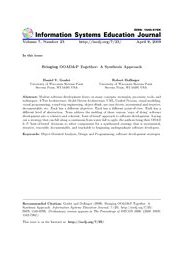Volume 7
Volume 7, Number 23 |
April 9, 2009 |
Abstract: Modern software development draws on many concepts, strategies, processes, tools, and techniques: 3-Tier Architecture, Model Driven Architecture, UML, Unified Process, visual modeling, visual programming, round-trip engineering, object-think, use case driven, incremental and iterative, documentable, etc. Each has a different objective. Each has a different point-of-view. Each has a different level of abstraction. None address the melding of these various ‘ways of doing’ software development into a cohesive and coherent, ‘best-of-breed’ approach to software development. Laying out a strategy that can fall along a continuum from water-fall to agile, the authors bring their OOAD & P ‘best-of-breed’ decisions to select components for a synthesized strategy that is incremental, iterative, traceable, documentable, and teachable to beginning undergraduate software developers.
Keywords: Object-Oriented Analysis, Design and Programming; software development strategies
Download this issue: ISEDJ.7(23).Goulet.pdf (Adobe PDF, 19 pages, 1435 K bytes)
Preview the contents: Goulet.j.txt (ASCII txt, 38 K bytes)
Recommended Citation: Goulet and Dollinger (2009). Bringing OOAD&P Together: A Synthesis Approach. Information Systems Education Journal, 7 (23). http://isedj.org/7/23/. ISSN: 1545-679X. (A preliminary version appears in The Proceedings of ISECON 2006: §2333. ISSN: 1542-7382.)
